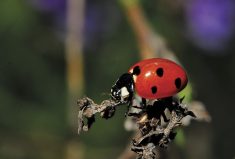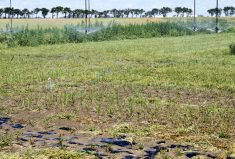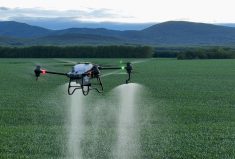They’re in your field, lurking there, doing their thing. But do you know who they are? Can you identify your beneficial insects?
That’s the goal behind the Western Grains Research Foundation’s Field Heroes campaign.
“It’s basically a social media campaign to increase the profile of the beneficial insects that are in your field crops,” said Tyler Wist, a field crop entomologist with Agriculture and Agri-Food Canada in Saskatoon. “It’s got fun facts that are really useful to know.”
The campaign aims to get farmers to think about beneficials before they spray, especially using economic thresholds so they don’t spray unnecessarily. The initiative’s website has a variety of scouting guides detailing beneficials that attack common crop pests. For example, lady beetles, lacewings, and damsel bugs are among the insects that eat aphids — a single thirteen-spotted lady beetle can eat up to 160 aphids in a 24-hour period.
Read Also

Hail research hopes to benefit potato growers
Alberta research scientist measures hail storm and heat dome affects on potato crops
The whole campaign is designed to foster a love of beneficials and to teach people when they should and shouldn’t spray, said Wist.
Producers can learn more by signing up for a weekly newsletter.
Through the campaign, beneficials are broken into various categories, like the “pulse avengers,” “cereal avengers,” and “oilseed avengers.” Each are grouped into classes of beneficial insects that can be found in the field.
Producers can interact with bug experts through Twitter and post pictures of any critter they find in their field if they want more information about it.
In order to encourage good bugs, it’s a good idea for producers to preserve natural areas, such as ditches that insect predators like ground beetles will use as a base.
“They like to eat wheat midge cocoons in the ground. They will eat bertha army worm cocoons. They only come out at night so you hardly ever see them,” said Wist. “Most of them are nocturnal. They come out and they sweep the ground clean.”
And while everyone knows what lady beetles look like, most people wouldn’t recognize their larvae.
“Aphids are their favourite food but they will also eat smaller caterpillars like diamondback moths. They’ll take those out,” he said.
Green lacewings are so voracious, they’re known as ‘aphid lions.’
“They will kill anything that moves in the field including each other,” said Wist. “They’re really a top predator out there.”
Another bunch of beneficial insects are the parasitoid wasps. One variety, called Macroglenes penetrans, will take out 30 to 40 per cent of overwintering wheat midge in a field.
“Try to preserve them when you’re thinking of spraying for wheat midge,” said Wist. “If you want to preserve them, you don’t spray later on when the midge are flying because that is also when the Macroglenes penetrans is around.”
Some producers might be alarmed by big orange wasps in their fields, said Wist; they sting bertha army worms, not people.
Many beneficial species need to feed on nectar and like flowering plants.
“If you’ve got an abundance of flowering plants in an area, you’ll have beneficials as well because you’re able to feed them,” he said. “Having a monoculture in your ditches might be good for baling, but it doesn’t do the beneficial insects a whole lot of good.”
Canola is a potential source of nectar for beneficials, so producers should never spray the crop at full flower, especially during the daytime when beneficials and pollinators are about.
“You may not think about it but if you have your wheat midge parasitoid and it’s feeding in the next canola field and you spray your canola, you could affect your wheat midge as well,” said Wist. “The whole ecosystem is really connected.”
Producers who want to learn more about beneficials can use a variety of websites or apps. In addition to fieldheroes.ca, Wist recommends the free Cereal Aphid manager app for smartphones, and the websites bugwood.org, bugguide.net and Inaturalist.org.

















